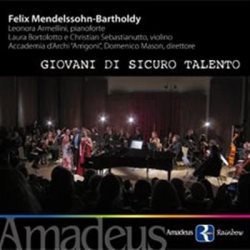| 
Support us financially by purchasing this from |
 |
|
Felix MENDELSSOHN (1809-1847)
String Symphony No.10 in B minor (1823) [12:44]
Concerto for violin and string orchestra in D minor (1822) [25:39]
Double Concerto for violin, piano and string orchestra in D minor (1823) [39:33]
Christian Sebastianutto (violin: Concerto in D minor)
Laura Bartolotto (violin) and Leonora Armellini (piano); Double Concerto
Accademia d’Archi ‘Arrigoni’/Domenico Mason
rec. March 2013, Fazioli Concert Hall, Sacile
AMADEUS RAINBOW ARB 008-2 [77:57]
The focus of this disc is youthful talent. This relates, clearly, to the youthful Mendelssohn who composed all three works between 1822 and 1823 and also the young soloists who interpret him here in a disc curated to showcase the musicians’ skill.
Domenico Mason is the conductor, and he directs the Accademia d’Archi ‘Arrigoni’, a chamber ensemble lined up 5-7-5-4-1. They too, obviously, are a band unburdened by age. With such a focus on youth it seems a shame, therefore, that we can read not a word about any of the soloists whose pictures we can see on the front and back of the booklet. The notes concentrate on matters Mendelssohnian, which is important too, but given that focus we should surely have had some biographical information. Mason is much better-known as an orchestral director but he is still not so well-known that he can do without a few lines.
Mendelssohn’s String Symphony No.10 in B minor is a marker, a milepost of his innovation, composed when he was fourteen. The pensiveness of the opening is well conveyed and equally well delivered in terms of intonation. The Allegro is very properly characterised in all its quixotic charm – ranging from ardent lyricism to moments of Dussek-like idiosyncrasy - before the outbursts in the Più presto bring us to a taut, satisfying end. The soloist in the Concerto in D minor is Christian Sebastianutto, a fine talent unafraid of rubati, whose slim tone suits the work. He has a good equalized scale and plays well in the solo recitatives of the central slow movement, a Volkslied whose lyricism he doesn’t indulge. He gets around the finale’s cadenza well, and conveys the Gavotte-like aura of the movement with resilience.
For the Double Concerto we have Laura Bartolotto (violin) and Leonora Armellini (piano) who, fortunately, work well as an ensemble because the concerto’s rhapsodic freedom requires them to act as a duo for some of the time. The violin pirouettes smartly and elegantly over the piano whilst slight but deft orchestral support – not least a fugato – ensures that incident isn’t stinted. The Mozartian element enshrined in the slow movement has real intimacy in this performance though I did feel the pinao was slightly backwardly balanced. The brisk and facile finale finds both young Italians in eager, accomplished mood.
This is fine souvenir of three promising young musicians, whose careers will assuredly be followed with interest and enthusiasm.
Jonathan Woolf
 |
 |
|
